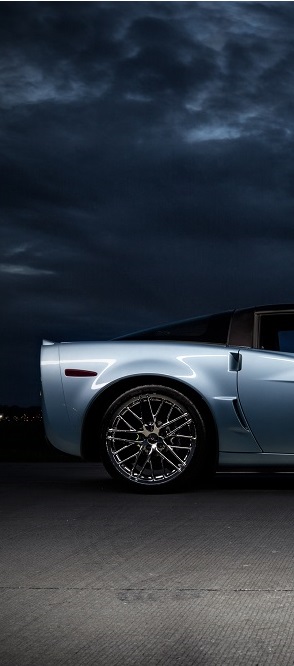

Pontiac GTO 1965-1967
The GTO was redesigned in 1965; while retaining the same wheel base and interior size the car got 3.1 inches longer and 100 lbs (45 kg) heavier. The dash has been revised as well as adding an optional and more legible tachometer and oil pressure gauge to instrument cluster with a breaker-less ignition as another option. The exterior changes include four headlights now stacked vertically and mounted in an “egg crate grill” while a functional hood scoop for cold air intake was added; as another bonus the scoop increased the roar of the accelerating engine. The brake linings are thicker by 15%, the front sway bar is beefed up, also heavy duty shocks were added and all included in the base price. The engine also received a makeover; high rise manifolds were added and the intake passages were re-cored on the head for cooler more efficient air intake. At 5,200 rpm with the basic four barrel the engine now developed 335 hp (250 kW); the high performance tri-power engine would develop 360 hp (370 kW) at the same 5,200 rpm. The three speed manual was the basic offering with the two speed auto or the four speed standard transmissions as optional choices. The lighter coupe with the four speed and power option would do 0 to 60 mph (97 km/h) in 5.8 seconds and a standing quarter mile in 14.5 seconds reaching a top speed of 114 mph at the 6,000 rpm red line.
For 1966 more changes the GTO became a model in its own right – it was not an option package any longer. The GTO could be ordered as a pillared sport coupe, a hardtop without pillars or as a convertible. In the passenger compartment higher and thinner bucket seats with contoured cushions were optional as well for the first time head rests could be chosen. On the dash the four circular instruments were redesigned and the ignition switch was moved from the far left to the right side of the steering column. The body became more curvy while the rear fenders had a”kicked up’ or coke bottle look and held the slightly tunneled tail lights with a louvered cover – a feature unique to GTO. The grill was also unique but in two ways – unique to the GTO as well it was the first plastic grill ever used on a production vehicle. Until this time the grills were all made of aluminum or a pot metal alloy. The car stayed on the same wheel base, with the same weight, but got slightly longer and wider with one inch wider tracking as well. The only change in the power train was a new Ram Air engine with the same horse power rating as the power option was offered but with few takers, there were only 35 factory Ram engines assembled and up to 300 dealer units put together.
There were few body changes for 1967 the louvered tail lights are four on each side and the grill is now a split one. The other changes were all cosmetic such as the GTO emblems were moved to the rocker panels from the fenders and colored lug nuts were offered for the alloy wheels. There were several mechanical changes for 1967. The 389 V8 engine was bored to 400 CID (6.5 L) with the cylinder heads redesigned so the valves would move in a straighter line allowing for larger valves to be installed. Three different choices for this engine were available but this year the Tri-Power carb – a Pontiac standard for years was not one of them. The economy package has a two barrel carburetor and produces 255 bhp (190 kW) at 4,400 rpm the standard engine puts out 335 bhp (250 kW) at 4,400 rpm with the high performance producing 360 bhp (270 kW) at 5,100 rpm This year saw many new safety features such as four way flashers, non-protruding knobs, padded dash, impact absorbing steering column, and wheel. Front disk brakes were an option and a four speed “his/hers” automatic transmission that allowed shifting through the gears if desired was an option while the two speed automatic was basic equipment.
Want more? click the link below to watch a driving the GTO video;
Republished by Blog Post Promoter
4 thoughts on “Pontiac GTO 1965-1967”
Comments are closed.












COOL!
The best sport/muscle machines ever!
Had two 1966 GTO’s one hard top one convertable!
Then why is the picture of a ’68?